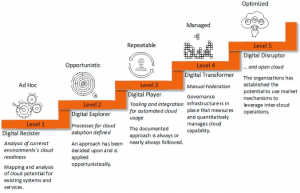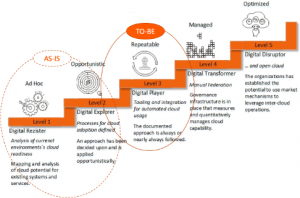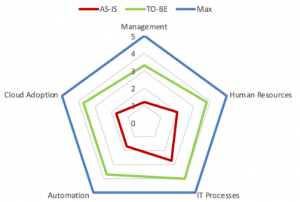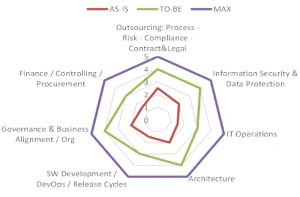What is your cloud maturity? Here's how to determine it

The key to IT change planning is to correctly describe the current situation. Only when we know what the cloud maturity of the organization is, we can correctly define the necessary steps on the way to the cloud and further development. In this article, I will show you how to assess cloud maturity, what is overestimated and what is underestimated in relation to cloud maturity.
Lukas Klášterský
In previous Encyclopedia of the Cloud articles about Cloud Journey we addressed the fact that every company has a history and different strengths and weaknesses. The key to developing a cloud strategy and roadmap is evaluate the maturity of teams and processesspecifically:
- what level of cloud maturity we want to achieve,
- the state of the application portfolio and which applications we want to migrate to the cloud,
- what the state of the cloud environment is and how it should adapt to the scale of application migration,
- what are the critical success factors and enablers or barriers to implementation,
- whether the current status is in compliance with regulations, laws, regulations or compliance (if I am a regulated entity).
Five levels of cloud maturity
Experience from large cloud projects led us to define five levels of company maturity in relation to the cloudwhich are closely linked to digitalisation:

We have described the individual stages in the article Cloud maturity: how mature am I for the cloud?.

In general, as a company grows more mature, our ability to manage and benefit from the cloud increases, while the risks decrease.
What can a cloud maturity assessment look like?
The following figure shows that if an organisation wants to start using the cloud on a regular basis, it needs to move to at least maturity level 3.

Cloud Maturity in Five Perspectives
Cloud deployment is a big change that the math is 1 + 1 = 3. When implementing large changes, it is advisable to choose tactics division of the project into smaller partsthat can be more easily analysed and changed (provided that each part contributes to the 'common goal').
In the case of cloud maturity, we have found it useful to evaluate the total 15 indicators in five views:

- Managerial
- Human Resources
- IT Processes
- Automation
- Cloud adoption
If we add to the indicators how the individual IT disciplines (architecture, infrastructure and operations, application development, security, governance and IT management, finance, compliance) approach the cloud, we have the basis for assessing the cloud maturity of companies worldwide. Let's look at the impact of each indicator on cloud maturity in more detail.
A) Management indicators
Management indicators determine how the organization intends to use the cloud, what goals it has set, and how management supports cloud initiatives.
- Cloud positioning - placement on a five-point scale from "no cloud" to "cloud first" determines the level of IT and management commitment to leverage the cloud for IT and business.
- Defining goals for cloud usage - How does the organization articulate what it wants to achieve in the cloud? How are the goals formalized and are they part of the business objectives? Without defining goals, the journey to the cloud is less impactful.
- Management support - this indicator tells whether and how the cloud is "visible" to management and what support management gives to the cloud in meeting the company's objectives (including regular reporting). Deferral of performance within organizations tends to be a big driver in achieving cloud goals.
B) Human resources indicators
Allocation of human resources, formalisation of roles and tools, together with the ability to innovate, tend to be essential for a successful journey to the cloud.
- Allocation of human resources - How does a company "virtually, dedicated or hybrid" organize individuals and entire teams in support of the cloud? Greater allocation of human resources and integration into the IT organization confirms the importance of cloud initiatives.
- Roles and tools - how does the organisation formally define roles for the cloud and which tools are available? Are they part of normal IT and business planning activities? The formalization of roles and tools in IT indicates whether cloud initiatives are more of a one-off or have become common practice.
- Innovation - The ability of an organisation to innovate is a good prerequisite for leveraging the cloud and its benefits. It is important whether the innovation is at the level of individuals, teams or the whole organisation and whether it is based on enthusiasm or is a systematic approach of the organisation.
C) IT process indicators
Cloud maturity is directly proportional to IT process maturity.
- Processes and their repeatability - The level of IT processes, their uniqueness or repeatability, their level of quality and sustainability, and the level of documentation reflect how the organisation can use the cloud.
- Level of process management in IT - How does the organization document, measure and evaluate IT processes - on a process-by-process basis, at process interfaces or as whole groups of related processes?
- Process ownership and efficiency measurement - How is IT process ownership and associated measurement managed? Do individual processes have owners (individuals or teams)? How often are quantity, quality and efficiency measured? The indicator suggests how easy or difficult it will be to take advantage of benefits in the cloud.
D) Automation indicators
The basic feature and essential benefit of the cloud is automation. The better IT and the organization is able to automate, the better prepared it is to leverage the cloud.
- Ability to automate in IT - directly indicates an organization's ability to benefit from cloud automation. IT efficiency depends on the ability to automate anything that is repetitive (on a scale of: not at all - some processes - by individual teams - wherever productivity can be improved - continuous optimization).
- Ability to leverage and scale resources - Can the organisation standardise and scale its IT resources? Then it's ready for automation in the cloud. Or does the organization prefer to create original and unique solutions? Then its journey to the cloud will be longer.
- Application and technology deployment methods - The way in which the build, deployment, and test of applications and environments is done indicates the level of DevOps in the development and operation of applications and technologies. The higher up the scale from manual to automated build of applications and environments to full orchestration (CI/CD) an organization has, the faster it can reap the benefits of the cloud.
E) Cloud Adoption Indicators
The direct indicators of cloud adoption are - an existing list of applications and technologies that can be migrated to the cloud (and which cannot); cloud readiness for migration or at least a plan for it; and knowledge of cloud technologies and innovations that can be afforded with them.
- The potential of the cloud for applications and technology - This indicator defines the level of commitment of an organisation to migrate applications and technologies to the cloud. The identification of potential can be random (on an application-by-application basis) to a systematic approach based on fixed criteria (across the entire portfolio) and roadmaps for both simple and complex migrations.
- Cloud readiness - How does the organization navigate the cloud provider environment? Can they set up the environment for their needs in a basic or advanced way? Is the organization able to manage multiple environments from different cloud providers?
- Knowledge of cloud technologies - how does the organization know the basic cloud technologies and basic migration options (close to on-premise), how does it handle more advanced technologies and related replatform migrations or innovative technologies (AI, Streaming, ...)?
Cloud maturity by indicators with examples
This sample review comes from from the banking sector. The assessment of cloud maturity in the individual indicator areas shows that the company's strengths lie in the areas of human resources and IT processes, while lower maturity is evident in the areas of automation, cloud adoption and management:

When we looked at the individual teams, it became clear that regulation plays an important role and the areas of architecture, security, outsourcing, compliance and governance are more mature compared to others.

What's overrated and underrated about cloud maturity
When developing cloud strategies, roadmaps or during the migration itself, we repeatedly find that some areas of cloud maturity assessment are overestimated in organizations and some are underestimated.
What is usually underestimated!
- Experimenting with the cloud will gradually move into real operation and the organisation of the team and processes will not be adjusted in time.
- Cloud platform management. On-premise doesn't have a unified dashboard, cloud does. Be mindful of your cloud environment (landing zone) setup, even with respect to the growth of your environment usage/amount of applications migrated.
- Capacity planning and financial management. On-premise capacity planning is done on an annual basis and budget management on a quarterly basis. In the cloud, you have to go an order of magnitude lower, capacity planning on a quarterly basis and managing cloud budgets on a monthly basis.
- Migrating applications to the cloud versus critical mass. If you're more conservative in your approach to what to move to the cloud, you won't get critical mass and won't be able to reap the full benefits of the cloud.
- Automation. In on-premise, you are not used to standardizing or automating, so it takes you some time to realize that standardizing will simplify your life and automating will simply increase efficiency.
- Risks and safety. Trust that the leading cloud providers offer many native security features (both free and paid) that are so easily integrated that your security teams will love them.
Which is usually overrated.
- Knowledge of cloud technologies and innovation. Yes, both are important, but you have to be able to use them to your advantage.
- Risks and safety. Fear of the unknown paralyses you unnecessarily when using the cloud. Risks need to be managed with common sense, regardless of whether it's on-premise or cloud.
- Cloud native apps solve everything. Yes, you can start developing applications in a cloud-based way, but that will ensure a gradual onboarding into the cloud. If you expect to use the cloud more, you need to think about what you will move from your existing applications.
- Migrating applications to the cloud versus preparing. If you're overly optimistic about what you want to move to the cloud and do insufficient preparation, you may find that your timeline is unrealistic in the middle of the migration.
- Automation will save me. Yes automation is a powerful native tool in the cloud, but you have to be ready to use it. Without the ability to standardize, measure and scale IT processes, automation is unattainable.
How would you rate your current cloud maturity? Are you satisfied with it or would you like to improve? Write your opinions in the comments.
... and stay tuned for more articles from our cloud encyclopedia series.




